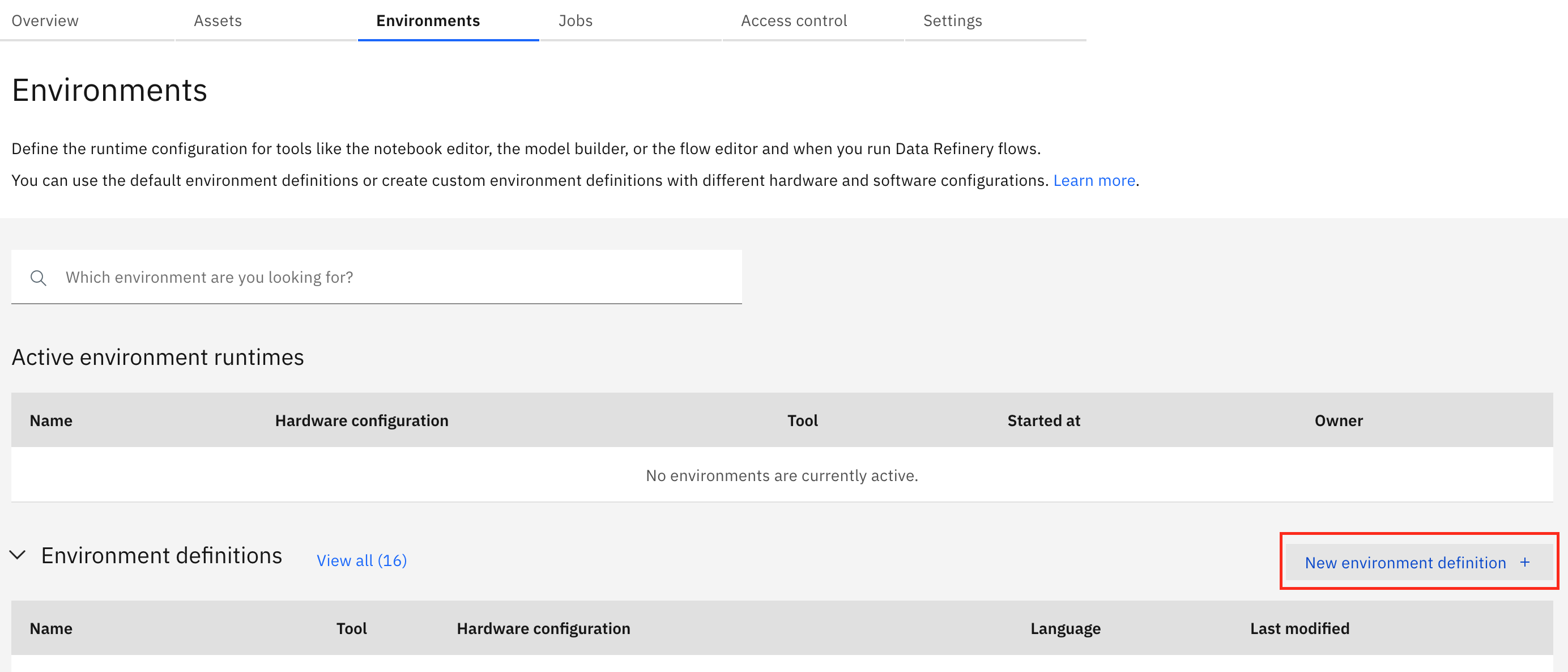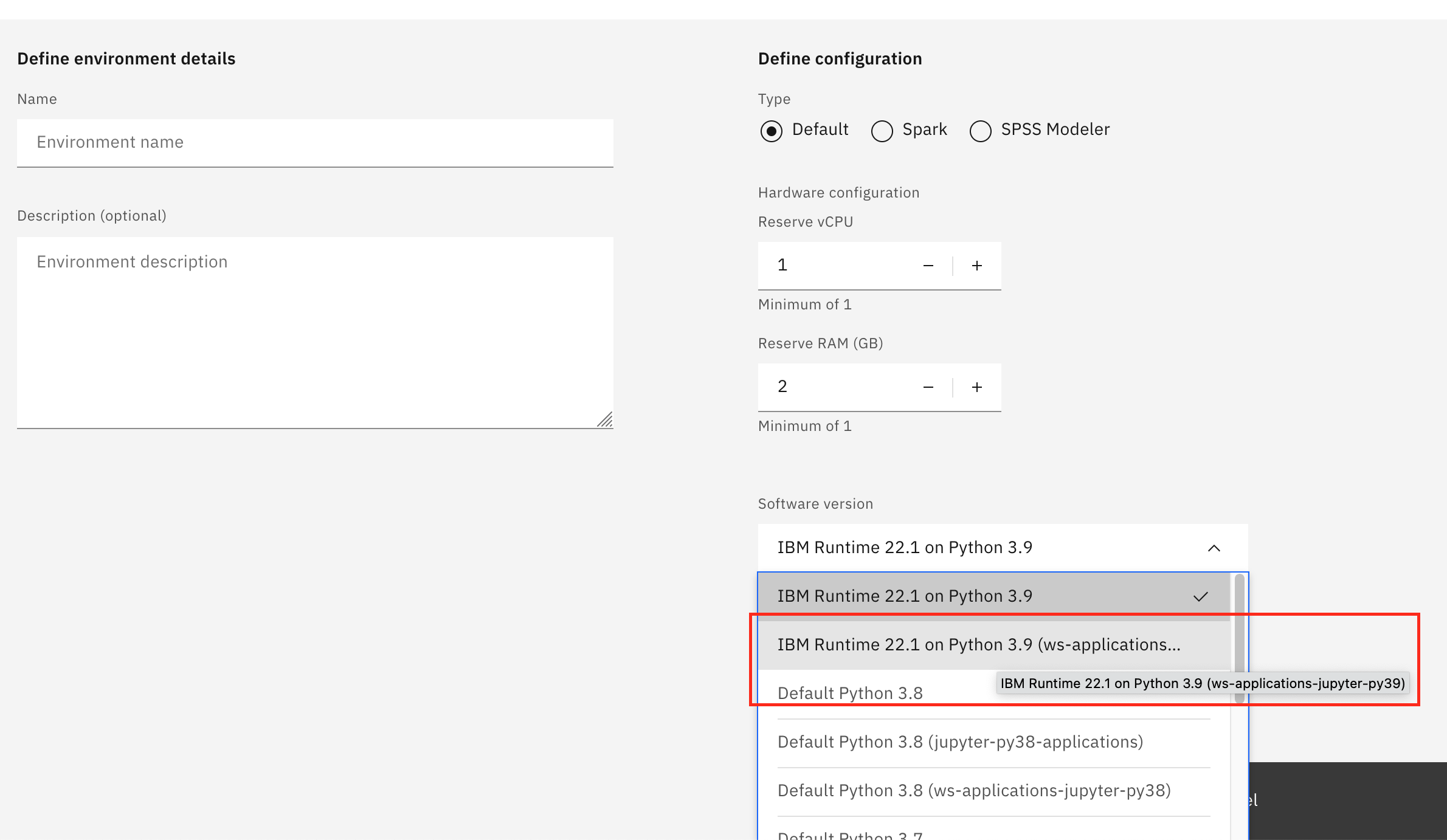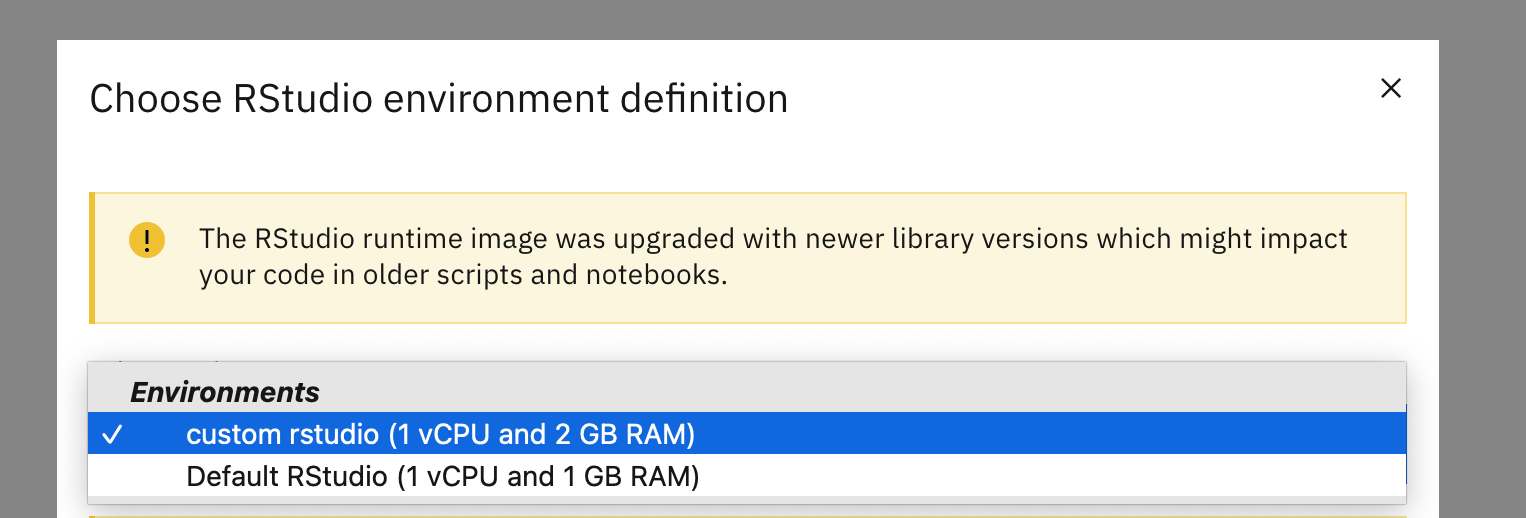Getting Started: Create Custom Images for Watson Studio (Cloud Pak for Data)
Preparation
Access to docker and container registries
Make sure that you
have docker installed in your environment
check and confirm that in your terminal, you are able to run docker commands by typing:
docker --help
have the username and password to
cp.icr.io, the container registry for base images (see this page if you do not know it)have the username and password to your container registry for custom images
configured the Cloud Pak for Data cluster to access your container registry for custom images (see this page if you have not done it yet)
Access to Cloud Pak for Data and/or OpenShift as admin
Everything is easier if you are an admin of the Cloud Pak for Data cluster you want to add a custom image to, with access to the OpenShift backend. If not, you may need to work with your Cloud Pak for Data admin and/or OpenShift admin to complete the whole process.
The access needed for each step will be specified separately.
Step 1: Get Base Image Names for Target Watson Studio Runtimes
All custom images to be used in Watson Studio need to be based on the default runtime images.
Access role required:
Cloud Pak for Data admin role
Run the following commands to set up your credentials to your Cloud Pak for Data cluster:
export CPD_BASE_URL=<your cpd link>
export CPD_USERNAME=<your username>
export CPD_APIKEY=<your apikey>
For example:
export CPD_BASE_URL=https://mycpd.com
export CPD_USERNAME=wendy
export CPD_APIKEY=ziE9KHmhKy2aHemKLeXa2CjTXpJbse8ZKjzoxH7d
(The above is a dummy example.)
Now you can run the following commands to list the base image names you are looking for:
python cli_ws_image.py default list --cpu # python jupyter environments, non-gpu
python cli_ws_image.py default list --gpu # python jupyter environments, gpu
python cli_ws_image.py default list -a # python jupyter environments, non-gpu + gpu
python cli_ws_image.py default list --rstudio # rstudio environments
If your Cloud Pak for Data is not the latest version, you need to specify which version it is on, because each Cloud Pak for Data version corresponds to a different set of base images that might have dependency on this specific version and cannot work properly on an older or newer version. This can be done by argument --cpd-version <version>. For example:
python cli_ws_image.py default list --cpu --cpd-version 4.0.6
If the output looks good, you can export the base image names into a text file by adding an argument --export-fn <filename>. For example:
python cli_ws_image.py default list --cpu --cpd-version 4.0.6 --export-fn base_images_nongpu_406.txt
You may use the overwrite flag --overwrite (or -o) to overwrite the file if it exists.
This exported text file is needed in the build step. You can of course create this text file of base image names manually.
Step 2. Build and push the custom image(s)
No matter how many base images you need to build a custom image for, you only have to run the build command once for each dockerfile.
What does it mean?
You may have created a dockerfile that you want to apply for both python 3.8 and python 3.9 base image. In this case, you can manually edit the base image list to keep only the image names you want to build a custom image for. The build command will loop through all the base image names in the list, build one custom image for each base image using the same dockerfile provided, and push all of them to the target container registery.
Access required:
username and password to the container registry for base images (
cp.icr.io)username and password to your container registry for custom images
1. Login to both container registry
Before running the build command, you need to authenticate to both the CPD base image container registry as well as your custom image container registry.
Note that:
base-image-list: this is the path to the file after switching to dir-dockerfile, not relative to where you run the command
custom-image-name-pattern: this is a name pattern, where
image_namecan be optionally used to refer to the original/base image name
1.1 CPD base image container registry
To login to cp.icr.io, run the following:
docker login cp.icr.io --username <username> --password <password>
If you do not have it, you will need openshift access to extract the credentials (see this page) or ask your openshift admin to do it.
1.2 custom image container registry
To login to the container registry for custom images, you can run a similar docker login command. If you are usng IBM Cloud Container Registry for this purpose, you can also use the following command:
ibmcloud login -g <resource-group> --apikey <iam-apikey> && ibmcloud cr login
If you intend to use CPD’s internal container registry for the custom images, the command will look like th following:
docker login -u $(oc whoami) -p $(oc whoami -t) default-route-openshift-image-registry.****
Likely you will encounter the insecure registry issue. To resolve it, you may refer to this page in Docker documnetaion.
2. Run CLI command
The custom build command builds the custom images and optionally pushes each of them to the target container registry for custom images.
2.1 Separate build and push
In some situations you may not want to run both build and push together. It might be that a developer builds the image, then an IT admin pushes it to the registry. This is possible with the CLI tool.
Build
python cli_ws_image.py custom build --dir-dockerfile <directory-of-dockerfile> --base-image-list <path-to-base-image-list> --custom-image-name-pattern <pattern>
Example commands:
python cli_ws_image.py custom build --dir-dockerfile ../custom-image --base-image-list base_images_nongpu_408.txt --custom-image-name-pattern {image_name}-ws-applications
python cli_ws_image.py custom build --dir-dockerfile . --base-image-list base_images_wmlpython_407.txt --custom-image-name-pattern {image_name}-custom
Push
python cli_ws_image.py custom push --base-image-list <path-to-base-image-list> --custom-image-name-pattern <pattern> --registry-url <registry-for-custom-image> --registry-namespace <namespace>
Example commands:
# push using info from base image list, easy for pushing custom images based on multiple base images
python cli_ws_image.py custom push --base-image-list ./base_images_wmlpython_408.txt --custom-image-name-pattern {image_name}-custom --registry-url us.icr.io --registry-namespace cpd-custom-image
# push using image name
python cli_ws_image.py custom push --image-name wml-deployment-runtime-py39-1-custom --custom-image-name-pattern {image_name}-custom --registry-url us.icr.io --registry-namespace cpd-custom-image
2.2 Build & Push in one command
In some other times, it might be eaiser to do both build and push together. You can use the --push flag to enable this, and provide the needed information.
python cli_ws_image.py custom build --dir-dockerfile <directory-of-dockerfile> --base-image-list <path-to-base-image-list> --custom-image-name-pattern <pattern> --push --registry-url <registry-for-custom-image> --registry-namespace <namespace>
For example:
python cli_ws_image.py custom build --dir-dockerfile . --base-image-list base_images_wmlpython_407.txt --custom-image-name-pattern {image_name}-custom --push --registry-url us.icr.io --registry-namespace cpd-custom-image
Step 3. Register in CPD Service
In order to use the custom image, the target service in Cloud Pak for Data needs to be aware of this image.
For Watson Studio, this involves:
a new or updated runtime config
For Watson Machine Learning, this involves:
a new or updated software specification
a new or updated runtime config
Access role required:
Cloud Pak for Data admin role
The following command registers ONE custom image in Watson Studio:
python cli_ws_image.py custom register
If you have multiple custom images, you may need to run the command for multiple times, unless you created one custom image to be registered for each available Python Jupyter runtime (there is only 1 Rstudio runtime as of 4.0.x so you won’t encounter this for Rstudio).
Note that:
You may use the flag
--dry-runto test the command and assess the generated json file, without really adding it to Watson Studio’s runtime definitions.Use argument
--cpd-versionor-vif the Cloud Pak for Data cluster is not on the latest version. This information is used to get all the candidate runtime definitions for this version.Use argument
--python-versionor-pyif there are multiple candidate runtime definitions for this Cloud Pak for Data version (usually each corresponds to a different python version), and you want to register a custom image for only a specific python version.--runtime-filename-patternor-c: used to provide a filename pattern for each final config file (one for each final candidate runtime definitions). By default it iscustom-{filename}, where{filename}refers to the original config filename. Note that{filename}has to be at the end of the pattern (do not add anything after it).--display-name-patternord: used to provide a display name pattern in each final config file. By default it is{display_name} (custom).--image-name-patternor-i: used to provide an image name pattern for each custom image. By default it isus.icr.io/custom-image/{image_name}-custom:2, where{image_name}refers to the original image name of the base image, similar to the previous commands.
3.1 Python Jupyter
Special arguments to use:
You need to specify one of
--jupyter(to generate config for jupyter notebook runtimes only),--jupyterlab(to generate config for jupyterlab runtimes only), or--jupyter-all(to generate config for both jupyter notebook and jupyterlab runtimes).
The command looks like the following:
python cli_ws_image.py custom register --jupyter-all -r <runtime-filename-pattern> -d <display-name-pattern> -i <image-name-pattern>
For example:
python cli_ws_image.py custom register --jupyter-all -r ws-applications-408-{filename} -d "{display_name} (ws applications)" -i us.icr.io/custom-image-ws-applications/{image_name}-ws-applications:4.0.8 -v 4.0.8
3.2 Rstudio
Special arguments to use:
You need to specify
--rstudio.
The command looks like the following:
python cli_ws_image.py custom register --rstudio -r <runtime-filename-pattern> -d <display-name-pattern> -i <image-name-pattern>
For example:
python cli_ws_image.py custom register --rstudio -r custom-408-{filename} -d "{display_name} (custom)" -i us.icr.io/cpd-custom-image/{image_name}-custom:23 -v 4.0.8
Step 4. Test New Environment
Now you can go to the Cloud Pak for Data cluster, enter a Watson Studio project where your new environment is allowed to be used (e.g., JupyterLab environment is only available in a Git-connected project).
Access role required:
None
Click on the New environment definition button:

Then from the dropdown list, you should be able to find and choose the custom runtime you just registered for the custom image:

Once you created a new environment definition using the custom runtime, you can test it in the following way.
For JupyterLab or Rstudio environments, click Launch IDE -> JupyterLab or Rstudio, then choose the new environment definition from the dropdown list.


For Jupyter Notebook environments, open an exsiting notebook with this new environment definition, or click on this New notebook button to open a new notebook using this definition.

It can take a while for the environment to start, because the image needs to be pulled to the worker node. If you have openshift access, you will be able to see the pod events to track the progress.